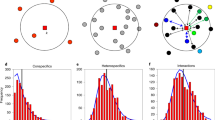Abstract
The nonrandom spatial structure of terrestrial plants is formed by ecological interactions and reproduction with a limited dispersal range, and in turn this may strongly affect population dynamics and population genetics. The traditional method of modelling in population ecology is either to neglect spatial pattern (e.g. in transition matrix models) or to do straightforward computer simulation. We review here three analytical mothods to deal with plant populations in a lattice-structured habitat, which propagate both by seeds that scatter over the whole habitat and by vegetative reproduction (producing runners, rhizomes, etc.) to neighboring vacant sites. [1]Dynamics of global and local densities: Dynamical equations of population density considering nearest-neighbor correlation (spatial clumping) are developed as the joint dynamics of global average density and local density (comparable to mean crowding) based onpair approximation. If there is a linear trade-off between seed production and vegetative reproduction, the equilibrium abundance of the population may be maximized by engaging both means of reproduction. This result is accurately predicted by the pair approximation method, but not by mean-field approximation (neglect of spatial structure). [2]Cluster size distributions: Using global and local densities obtained by pair approximation, we predicted cluster size distribution, i.e. the number of clusters of occupied sites of various sizes. [3]Clonal identity probability decreasing with distance: Multi-locus measurement of allozymes or other neutral molecular markers tells us whether or not a given pair of individuals belong to the same clone. From the pattern of clonal identity probability decreasing with the distance between ramets, we can estimate the relative importance of two modes of reproduction: vegetative propagation and sexual seed production.
Similar content being viewed by others
References
Boerlijst, M. C. and P. Hogeweg (1995) Attractors and spatial patterns in hypercycles with negative interactions.Journal of Theoretical Biology 176: 199–210.
Callaghan, T. V. (1988) Physiological and demographic implications of modular construction in cold environments. pp 111–136.In A. D. Davy, M. J. Hutchings and A. R. Watkinson (eds.)Plant population ecology Blackwell, Oxford.
Caswell, H. (1989)Matrix population models: construction, analysis, and interpretation. Sinauer Associations, Sunderland, Massachusetts.
Caswell, H. and R. J. Etter (1992) Ecological interactions in patchy environments: from patch-occupancy models to cellular automata. pp. 93–109.In S. A. Levin, T. M. Powell and J. H. Steele (eds.)Patch dynamics, Springer, New York.
Cook, R. E. (1983) Clonal plant populations.American Scientist 71: 244–253.
Durret, R. and C. Neuhauser (1994) Particle systems and reaction-diffusion equations.Annals of Probability 22: 289–333.
Grim, P (1995) The greater generosity of the spacialized prisoner's dilemma.Journal of theoretical Biology 173: 353–359.
Harada, Y. and Y. Iwasa (1994) Lattice population dynamics for plants with dispersing seeds and vegetative propagation.Researches on Population Ecology 36: 237–249.
Harada, Y., H. Ezoe, Y. Iwasa, H. Matsuda and K. Sato (1995) Population persistence and spatially limited social interaction.Theoretical Population Biology 48: 65–91.
Hassell, M. P. and R. M. May (1974) Aggregation in predators and insect parasites and its effect on stability.Journal of Animal Ecology 43: 567–594.
Herz, A. V. M. (1994) Collective phenomena in spatially extended evolutionary games.Journal of theoretical Biology 169: 65–87.
Hubbell, S. P. and R. B. Foster (1986) Canopy gaps and the dynamics of a neotropical forest. pp. 77–96.In M. J. Crawley (ed.)Plant ecology. Blackwell, Oxford.
Ives, A. R. and R. M. May (1985) Competition within and between species in a patchy environment.Journal of Theoretical Biology 115: 65–92.
Iwao, S. (1968) A new regression method for analyzing the aggregation pattern of animal populations.Researches on Population Ecology 10: 1–20
Iwasa, Y. and E. Teramoto (1977) A mathematical model for the formation of a distributional pattern and an index of aggregation.Japanese Journal of Ecology 27: 117–124.
Iwasa, Y. and E. Teramoto (1984) Branching-diffusion model for the formation of distributional patterns in populations.Journal of Mathematical Biology 19: 109–124.
Kawano, S., T. Takada, S. Nakayama and A. Hiratsuka (1987) Demographic differentiation and life-history evolution in temperate woodland plants. pp 153–181.In K. M. Urbanska (ed.)Differentiation patterns in higher plants. Academic Press, New York.
Kimura, M. and G. H. Weiss (1964) The stepping stone model of population structure and the decrease of genetic correlation with distance.Genetics 49: 561–176.
Konno, N and K. Sato (1995) Upper bounds on order parameters of diffusive contact processes.Journal of the Physical Society of Japan 7: 2405–2412.
Kubo, T., Y. Iwasa and N. Furumoto (1996) Forest spatial dynamics with gap expansion: total gap area and gap size distribution.Journal of Theoretical Biology (in press)
Kuno, E. (1968) Studies on the population dynamics of rice leafhoppers in a paddy field.Bulletin of the Kyushu Agricultural Experiment Station 14: 137–246.
Lloyd, M. (1967) Mean crowding.Journal of Animal Ecology 36: 1–30.
Matsuda, H., N. Ogita, A. Sasaki and K. Sato (1992) Statistical mechanics of population—The lattice Lotka-Volterra model.Progressive Theory of Physics 88: 1035–1049.
Mochizuki, A., Y. Iwasa and Y. Takeda (1996) A stochastic model for cell sorting and measuring cell-cell adhesion.Journal of Theoretical Biology (in press)
Pielou, E. C. (1974)Mathematical ecology. Wiley, New York
Raven, P. H., R. F. Evert and H. Curtis (1981)Biology of plants. 3rd ed. Worth Publ. Inc., New York.
Pipley, B. D. (1977) Modeling spatial patterns.Journal of the Royal Statistical Society B39: 172–212
Sato, K., H. Matsuda and A. Sasaki (1994) Pathogen invasion and host extinction in lattice structured populations.Journal of Mathematical Biology 32: 251–268.
Silvertown, J. W. (1987)Introduction to plant population ecology. 2ned ed. Longman, London.
Stauffer, D. (1975)Introduction to percolation theory. Taylor and Francis, London.
Sykes, M. F. and M. Glen (1983) Percolation processes in two dimensions I. Low-density series expansions.Journal of Physics A 9: 87–95.
Wilson, W. G., A. M. de Roos and E. McCailey (1993) Spatial instabilities within the diffusive Lotka-Volterra system: individual-based simulation results.Theoretical Population Biology 43: 91–127.
Author information
Authors and Affiliations
Rights and permissions
About this article
Cite this article
Harada, Y., Iwasa, Y. Analyses of spatial patterns and population processes of clonal plants. Res Popul Ecol 38, 153–164 (1996). https://doi.org/10.1007/BF02515723
Received:
Accepted:
Issue Date:
DOI: https://doi.org/10.1007/BF02515723




